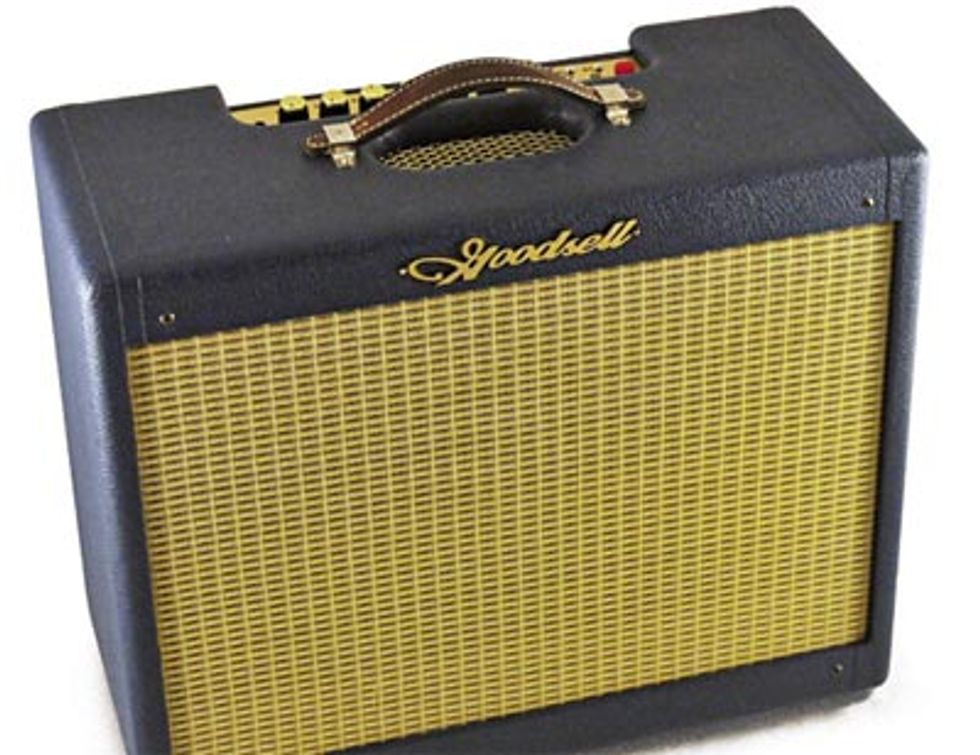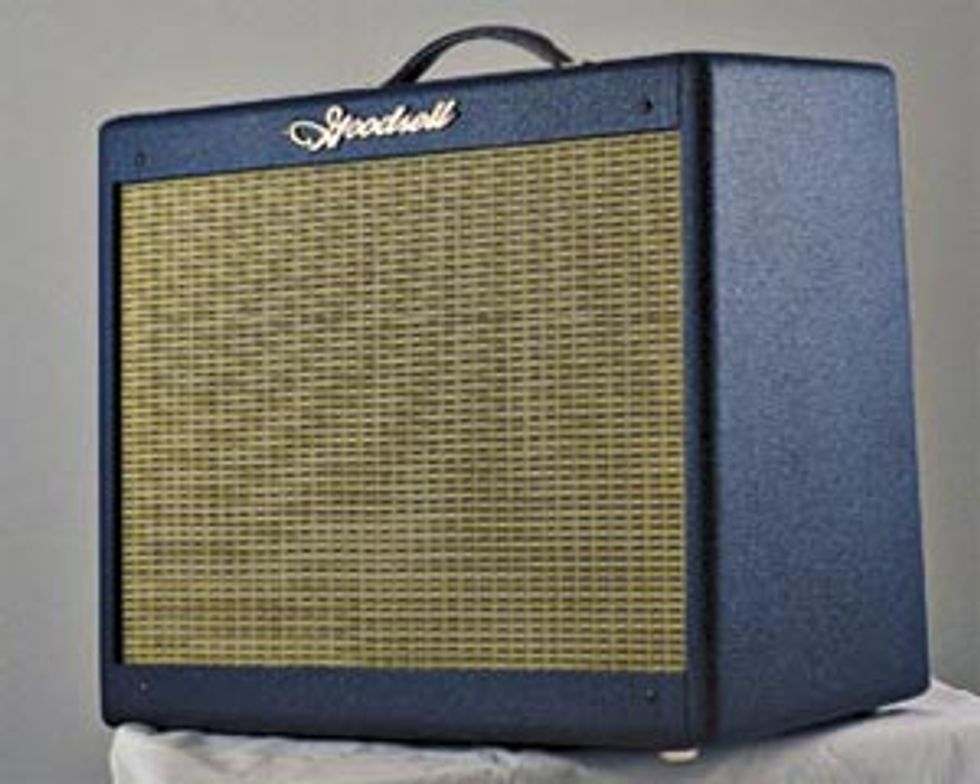 In a recent interview, Richard Goodsell told us that, “I am unpretentious and my products show it.” Anyone who has spent more than five minutes with Richard would probably agree with his description of both himself and his amplifiers, perhaps adding “kinetic,” “passionate,” and even “a little cocky.” His past amp designs have been exercises in simplicity, based on designs and techniques he picked up as a Hammond organ guy and have tended to reflect his personality. So why has the master of the haiku-like circuit added extra knobs across the top of the new Super Seventeen Mark Three?
In a recent interview, Richard Goodsell told us that, “I am unpretentious and my products show it.” Anyone who has spent more than five minutes with Richard would probably agree with his description of both himself and his amplifiers, perhaps adding “kinetic,” “passionate,” and even “a little cocky.” His past amp designs have been exercises in simplicity, based on designs and techniques he picked up as a Hammond organ guy and have tended to reflect his personality. So why has the master of the haiku-like circuit added extra knobs across the top of the new Super Seventeen Mark Three? “It kills me to make six knob amps after making three knob amps for so long.” Well, you’re forgiven, Mr. Goodsell, because there aren’t any cascading gain stages or semi-parametric EQs tucked away anywhere. The three additional, distressful knobs are there to control the Rate and Depth of the tremolo circuit and the general workings of the reverb, making the new Mark Three as unpretentious as Goodsell’s other designs.
The prototype we tested displayed remarkable craftsmanship. The stamped-steel chassis (aluminum on production models) features point-to-point wiring with short leads and tidy workmanship throughout. The chassis and top-mounted controls are fixed to the back of the cover plate, which are then mounted to the Fender-style enclosure via threaded inserts. Richard informs us that production models will be switching over to T-nuts as a concession to the added weight. Despite our sample’s blue tolex cover, the Goodsell has a classic, tweed Fender vibe, the only giveaways being the vent under the leather handle and Marshall-esque control panel and knobs.
"Whether the Mark Three''s tones are due to the careful selection of transformers and carbon comp resistors, or chicken bones and holy water, Richard''s onto something"

Toneful Simplicity
Selecting 17 Watt mode, killing the reverb and trem, setting the Gain and Tone at noon and the Volume at one o’clock, the Mark Three, in a ménage à trois with a Nocaster and a 10’ Mogami, oozed slightly overdriven, three-dimensional “Class A” tones – beautiful EL84 chime and sparkle with none of that all-too-common brittleness. The wound strings even got in on the act when hit hard enough. Richard explains, “What you describe as ‘Class A’ is cathode biasing – I don’t know why anyone would build an amp any other way. As far as lack of brittleness goes, that’s going to be in places like coupling caps, how hard you’re hitting the front of the amp and the phase inverter – it’s basically a selection of components.” Whether the Mark Three’s tones are due to the careful selection of transformers and carbon comp resistors, or chicken bones and holy water, Richard’s onto something.
The amp continued to throw curve balls. A quick peek under the hood reveals a matched pair of EH EL84s, not what my ears had told my eyes to expect. “People buy my amps, take them home that night and email me. They want to know what tubes I would put in. My response is simple: the tubes that are in there – the $20 pair of Electro-Harmonix that I match at my shop.” While this might seem to go against common wisdom, it actually makes a lot of sense. It allows Goodsell to produce killer sounding amps consistently, as well as allowing players to buy replacements at any local mom and pop store.
While still in 17 Watt mode, with the Gain and Tone controls set politely, the Mark Three sounds decidedly Liverpudlian. Roll up the Gain control and it starts sounding like a tweed – or even a brownface – Deluxe. In fact, with the Gain at three o’clock and above, the Tone control even does that “boosting” thing that tweed Deluxe tone controls do when pushed. While more mids are certainly present in this mode, it never gets that truly boxy lower-mid tone, instead keeping plenty of sparkle to retain its identity.
Where I found the real magic in this amp was with the more conservative, not quite broken up, not quite clean settings. A hard attack delivered a focused, Fender-flavored bottom-end on open chords, while a softer pick attack or fingers offered up some amazingly clear and deep single note passages with just the right amount of sustain. While the Super Seventeen has its own thing going on, in this mode I kept finding myself returning to J.J Cale licks. Backing off on the guitar’s volume and digging in with a pick delivered an amazing clean tone, with a nice, slightly nasal mid flavor that made everything from Harrison riffs to Don Rich twang come alive. Here, the amp’s natural compression kept a harder attack from breaking up, adding some sweet sustain before allowing notes and chords to drop off and decay.
Throughout all of this – running a Teletype guitar, clean and overdriven through an EL84 powered 1×12” combo – the Goodsell refused to get brittle. Of course, there was enough cut to be heard, and that telltale chime never went away, but the amp remained ear-friendly throughout.
 Switching over to 5 Watts is achieved by flipping a switch that changes the output tubes from pentode operation in 17 Watts to triode in 5 Watt mode. Rather than look at this as a way to go from club gig to bedroom, instead look at it as another tone control. Leaving the Volume up around three o’ clock and the Gain and Tone at noon, the amp delivered a more Fendery sounding midrange, although with more of a Princeton fingerprint than Deluxe. The mids warmed up and a lot of the upper-end harmonic complexity went away – although this is by no means a bad thing. Cranking up the Gain and Tone controls reminded us how much fun (and loud) a lower-wattage and “less harmonically complex” amp running balls out can be. The Goodsell was delightfully sputtery and raunchy, making me wish I had some bell-bottoms and a Zemaitis so I could try out my new Ronnie Wood impersonation, which involves strutting around playing “Stay With Me” without dropping my ash or kicking over my bourbon and Coke.
Switching over to 5 Watts is achieved by flipping a switch that changes the output tubes from pentode operation in 17 Watts to triode in 5 Watt mode. Rather than look at this as a way to go from club gig to bedroom, instead look at it as another tone control. Leaving the Volume up around three o’ clock and the Gain and Tone at noon, the amp delivered a more Fendery sounding midrange, although with more of a Princeton fingerprint than Deluxe. The mids warmed up and a lot of the upper-end harmonic complexity went away – although this is by no means a bad thing. Cranking up the Gain and Tone controls reminded us how much fun (and loud) a lower-wattage and “less harmonically complex” amp running balls out can be. The Goodsell was delightfully sputtery and raunchy, making me wish I had some bell-bottoms and a Zemaitis so I could try out my new Ronnie Wood impersonation, which involves strutting around playing “Stay With Me” without dropping my ash or kicking over my bourbon and Coke. The Goodsell RGM speaker is yet another well matched component to the Mark Three, tending to stay out of the amp’s way. If it leans one way or the other, it would be a few clicks East of the Prime Meridian, but thankfully it veers well away from any honky midrange breakup that can sometimes plague modern interpretations of classic British speakers. The really cool thing was its ability to offer up just the right amount of coloration when pushed in 5 Watt mode, while staying as clear as a mountain stream when played cleanly in 17 Watt mode. Never once did the bottom-end fart out, yet it never sounded tight or cold, either.
In addition to the 17W/5W switch, the Mark Three’s big news is the addition of tremolo and reverb. Initially based on a single-ended, late-fifties Gibson circuit, the trem has been put through Goodsell’s typical refinement process, and will steal your heart. Richard will be the first to admit that the Speed and Depth controls are almost superfluous. “It doesn’t go extremely slow nor does it go extremely fast. Part of that is bias-varying tremolo and it sounds fantastic.” I would have to agree that it isn’t the most flexible trem around, but it doesn’t matter in the least – it’s still hypnotic as hell. In either wattage mode, I found myself tending to land on Speed at around two o’clock and Depth almost all the way up, but mixing the trem with the delicious mids of an almost clean 17 Watt setting left a wet spot. The tremolo circuit is also foot-switchable, and Richard assures us that there is no tonal difference between his trem and non-trem models when the controls are turned at zero.
The Reverb is almost disappointing in that it isn’t reinvented here, just refined and tuned really well to the Mark Three. It blends in well at lower settings, adding a little air, and at higher settings delivers enough spronk to bust out some close to authentic “Miserlou” tones. Goodsell has done a good job here of helping a single control cover a lot of ground.
The Final Mojo
Richard Goodsell has taken all that is good from the Mark Two series – a push-pull, cathode biased EL84 power amp section with no negative feedback loop, smart component choices, healthy plate voltages and his fresh perspective on amp design – and has delivered a flexible amp that produces several killer tones at functional yet still reasonable volumes. Although the Mark Three always sounds like a Mark Three, it hints at a bastard amalgam of an AC15 and a tweed Deluxe in 17 Watt mode, and suggests an old Princeton in a 12” enclosure when producing 5 Watts. Add in thoughtful and nearly obsessive attention to detail and you have a winner.
Buy if...
you crave fresh, three-dimensional tones that hint at the past.
Skip if...
you''re looking for a specific vintage tone.
Rating...
MSRP $1999 - Goodseel Amplifers - superseventeen.com |
Our expert has stated their case, now we want to hear yours. Share your comments and ratings below.














